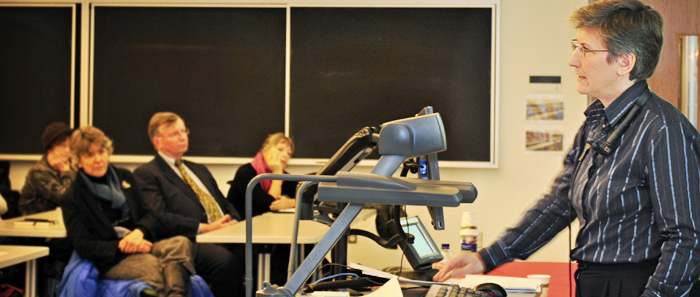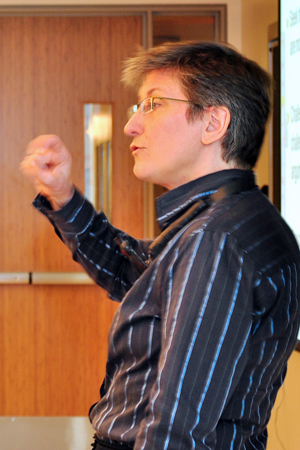
Jocelyn Downie, Canada Research Chair in Health Law and Policy at Dalhousie University, presented a case for changing the legal status of assisted suicide and euthanasia in Canada during McGill’s annual Lecture in Health and Law
By Pascal Zamprelli.
Despite a 1993 Supreme Court of Canada decision – the case of Sue Rodriguez – making it clear assisted suicide and euthanasia are illegal in Canada, both are occurring, but prosecutors by and large are not charging anyone. “It’s clearly prohibited, but it’s clearly happening,” said Jocelyn Downie, Canada Research Chair in Health Law and Policy at Dalhousie University. “We have a lot of cases, but people aren’t ending up in jail. There is a Disconnect between the law on the books and the law on the street.”
For her part, Downie believes the law on the books should be changed to allow for both assisted suicide and euthanasia, and she presented a compelling case during McGill’s annual Lecture in Health and Law, co-sponsored by the McGill Research Group on Health and Law and the McGill Biomedical Ethics Unit, with funding from the McGill Beatty Memorial Lecture Series.
Downie began with an important overview of terminology. There are in fact five different scenarios in the “care for the dying” spectrum that people have a tendency to confuse, three of which are legal in Canada and two of which are not. Withholding potentially life-sustaining treatment, such as a blood transfusion, at the request of a competent patient, is perfectly legal. Withdrawing potentially life-sustaining treatment (the ubiquitous “pulling the plug” scenario) is also legal, as is potentially life shortening symptom relief (for instance, increasing the levels of morphine for a dying patient in order to “stay ahead of the pain,” knowing this will likely kill the patient eventually).
None of these qualify as assisted suicide or euthanasia, both of which are illegal. The difference between assisted suicide and euthanasia is simply the “agent” of the act – with respect to the former, the patient takes the final act to end his or her own life but requires assistance to do so (i.e., someone prepares a lethal cocktail for them), while in the case of euthanasia the final act itself is performed by a third party, such as a doctor administering a lethal injection.
Downie believes there is no logical way to explain why some acts are illegal and others are not – noting, for instance, the physical and moral similarities between pulling the plug (legal) and a lethal injection (illegal). She presented three of the usual justifications for separating the scenarios into legal and illegal categories, each of which she believes fall apart under closer scrutiny: a distinction between acts and omissions, a distinction between a natural and an unnatural death, and a distinction between the intention to alleviate suffering and the intention to end life.

“The withdrawal of potentially life sustaining treatment is as much an act as assisted suicide and euthanasia are acts,” she said. “When you withdraw a respirator, you are doing something, and so withdrawing is an act.”
It follows for Downie that withdrawing potentially life-sustaining treatment causes a death no more “natural” than a lethal injection, because even though the disease is what ultimately ends life, it would not but for the withdrawal. Furthermore, the intention to alleviate suffering/intention to end life distinction also falls apart logically, because the ending of life is in fact the means to alleviate suffering, so the intention is fundamentally the same.
Downie also presented empirical evidence from other jurisdictions where assisted suicide and euthanasia are legal, such as the Netherlands and the state of Oregon, to demonstrate that legalization does not lead to increased recourse to assisted suicide or euthanasia, or abuse of the procedures leading to non-voluntary euthanasia for instance, as many opponents predict it would.
Recognizing that end of life law and policy is a “difficult, highly charged, complex area,” Downie also emphasized the importance of respectful engagement. “Too often discussions of euthanasia and assisted suicide devolve into sloganeering, shouting matches, and vitriolic ad hominems,” she said.
“We need to seek to understand what beliefs and values are motivating the positions of others. Then challenge their positions and be open to a challenge back about inconsistencies, about invalid arguments, about factual errors. Often we can come to agreement through this process. That said, there will still be times where you don’t come to agreement because you have a values disagreement. You can respect the remaining value differences.”
Photos: Lysanne Larose
